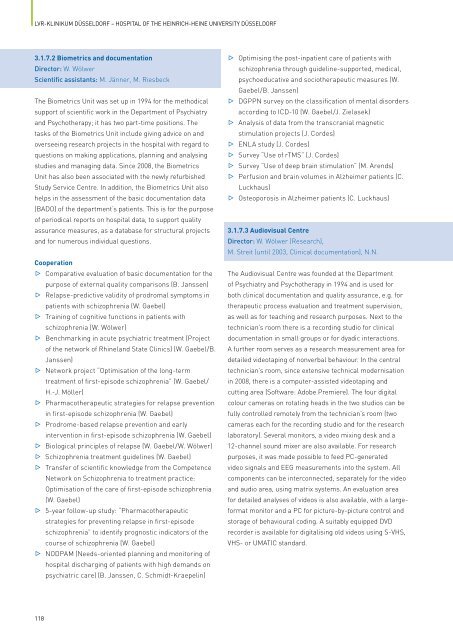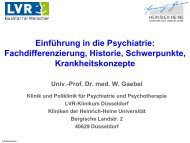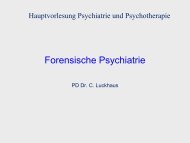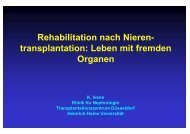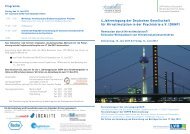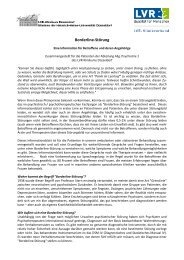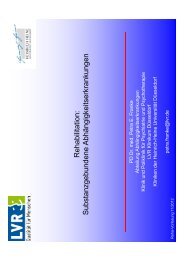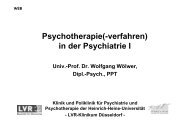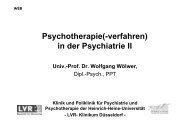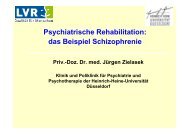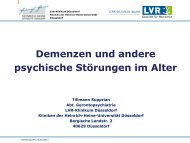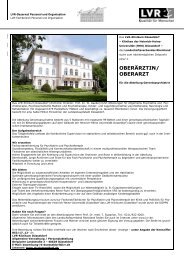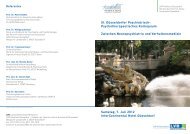LVR-Klinikum Düsseldorf Hospital of the Heinrich-Heine University ...
LVR-Klinikum Düsseldorf Hospital of the Heinrich-Heine University ...
LVR-Klinikum Düsseldorf Hospital of the Heinrich-Heine University ...
You also want an ePaper? Increase the reach of your titles
YUMPU automatically turns print PDFs into web optimized ePapers that Google loves.
<strong>LVR</strong>-KLINIKUM DÜsseLDORF – hOsPITaL OF The heINRIch-heINe UNIVeRsITY DÜsseLDORF<br />
3.1.7.2 Biometrics and documentation<br />
Director: W. Wölwer<br />
Scientific assistants: M. Jänner, M. Riesbeck<br />
The Biometrics Unit was set up in 1994 for <strong>the</strong> methodical<br />
support <strong>of</strong> scientific work in <strong>the</strong> Department <strong>of</strong> Psychiatry<br />
and Psycho<strong>the</strong>rapy; it has two part-time positions. The<br />
tasks <strong>of</strong> <strong>the</strong> Biometrics Unit include giving advice on and<br />
overseeing research projects in <strong>the</strong> hospital with regard to<br />
questions on making applications, planning and analysing<br />
studies and managing data. Since 2008, <strong>the</strong> Biometrics<br />
Unit has also been associated with <strong>the</strong> newly refurbished<br />
Study Service Centre. In addition, <strong>the</strong> Biometrics Unit also<br />
helps in <strong>the</strong> assessment <strong>of</strong> <strong>the</strong> basic documentation data<br />
(BADO) <strong>of</strong> <strong>the</strong> department’s patients. This is for <strong>the</strong> purpose<br />
<strong>of</strong> periodical reports on hospital data, to support quality<br />
assurance measures, as a database for structural projects<br />
and for numerous individual questions.<br />
Cooperation<br />
s Comparative evaluation <strong>of</strong> basic documentation for <strong>the</strong><br />
purpose <strong>of</strong> external quality comparisons (B. Janssen)<br />
s Relapse-predictive validity <strong>of</strong> prodromal symptoms in<br />
patients with schizophrenia (W. Gaebel)<br />
s Training <strong>of</strong> cognitive functions in patients with<br />
schizophrenia (W. Wölwer)<br />
s Benchmarking in acute psychiatric treatment (Project<br />
<strong>of</strong> <strong>the</strong> network <strong>of</strong> Rhineland State Clinics) (W. Gaebel/B.<br />
Janssen)<br />
s Network project “Optimisation <strong>of</strong> <strong>the</strong> long-term<br />
treatment <strong>of</strong> first-episode schizophrenia” (W. Gaebel/<br />
H.-J. Möller)<br />
s Pharmaco<strong>the</strong>rapeutic strategies for relapse prevention<br />
in first-episode schizophrenia (W. Gaebel)<br />
s Prodrome-based relapse prevention and early<br />
intervention in first-episode schizophrenia (W. Gaebel)<br />
s Biological principles <strong>of</strong> relapse (W. Gaebel/W. Wölwer)<br />
s Schizophrenia treatment guidelines (W. Gaebel)<br />
s Transfer <strong>of</strong> scientific knowledge from <strong>the</strong> Competence<br />
Network on Schizophrenia to treatment practice:<br />
Optimisation <strong>of</strong> <strong>the</strong> care <strong>of</strong> first-episode schizophrenia<br />
(W. Gaebel)<br />
s 5-year follow-up study: “Pharmaco<strong>the</strong>rapeutic<br />
strategies for preventing relapse in first-episode<br />
schizophrenia” to identify prognostic indicators <strong>of</strong> <strong>the</strong><br />
course <strong>of</strong> schizophrenia (W. Gaebel)<br />
s NODPAM (Needs-oriented planning and monitoring <strong>of</strong><br />
hospital discharging <strong>of</strong> patients with high demands on<br />
psychiatric care) (B. Janssen, C. Schmidt-Kraepelin)<br />
118<br />
s Optimising <strong>the</strong> post-inpatient care <strong>of</strong> patients with<br />
schizophrenia through guideline-supported, medical,<br />
psychoeducative and socio<strong>the</strong>rapeutic measures (W.<br />
Gaebel/B. Janssen)<br />
s DGPPN survey on <strong>the</strong> classification <strong>of</strong> mental disorders<br />
according to ICD-10 (W. Gaebel/J. Zielasek)<br />
s Analysis <strong>of</strong> data from <strong>the</strong> transcranial magnetic<br />
stimulation projects (J. Cordes)<br />
s ENLA study (J. Cordes)<br />
s Survey “Use <strong>of</strong> rTMS” (J. Cordes)<br />
s Survey “Use <strong>of</strong> deep brain stimulation” (M. Arends)<br />
s Perfusion and brain volumes in Alzheimer patients (C.<br />
Luckhaus)<br />
s Osteoporosis in Alzheimer patients (C. Luckhaus)<br />
3.1.7.3 Audiovisual Centre<br />
Director: W. Wölwer (Research),<br />
M. Streit (until 2003, Clinical documentation), N.N.<br />
The Audiovisual Centre was founded at <strong>the</strong> Department<br />
<strong>of</strong> Psychiatry and Psycho<strong>the</strong>rapy in 1994 and is used for<br />
both clinical documentation and quality assurance, e.g. for<br />
<strong>the</strong>rapeutic process evaluation and treatment supervision,<br />
as well as for teaching and research purposes. Next to <strong>the</strong><br />
technician’s room <strong>the</strong>re is a recording studio for clinical<br />
documentation in small groups or for dyadic interactions.<br />
A fur<strong>the</strong>r room serves as a research measurement area for<br />
detailed videotaping <strong>of</strong> nonverbal behaviour. In <strong>the</strong> central<br />
technician’s room, since extensive technical modernisation<br />
in 2008, <strong>the</strong>re is a computer-assisted videotaping and<br />
cutting area (S<strong>of</strong>tware: Adobe Premiere). The four digital<br />
colour cameras on rotating heads in <strong>the</strong> two studios can be<br />
fully controlled remotely from <strong>the</strong> technician’s room (two<br />
cameras each for <strong>the</strong> recording studio and for <strong>the</strong> research<br />
laboratory). Several monitors, a video mixing desk and a<br />
12-channel sound mixer are also available. For research<br />
purposes, it was made possible to feed PC-generated<br />
video signals and EEG measurements into <strong>the</strong> system. All<br />
components can be interconnected, separately for <strong>the</strong> video<br />
and audio area, using matrix systems. An evaluation area<br />
for detailed analyses <strong>of</strong> videos is also available, with a largeformat<br />
monitor and a PC for picture-by-picture control and<br />
storage <strong>of</strong> behavioural coding. A suitably equipped DVD<br />
recorder is available for digitalising old videos using S-VHS,<br />
VHS- or UMATIC standard.


